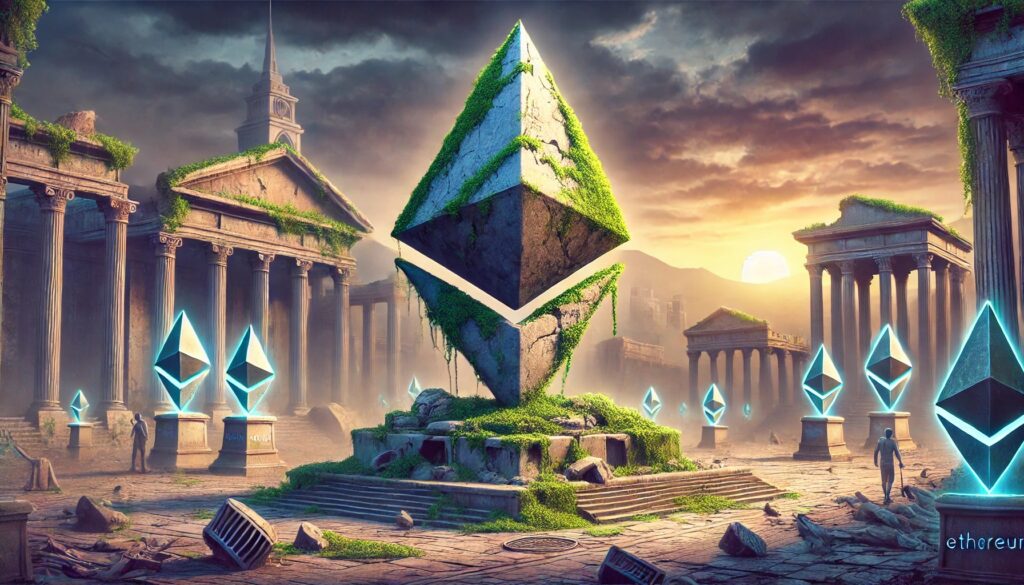In a charged statement on X, Justin Bons, founder and chief investment officer of Cyber Capital, one of Europe’s oldest cryptocurrency funds, expressed a critical view of Ethereum’s current trajectory, stating that “Ethereum is dying while L2 is dancing on its grave.” Bons argues that Ethereum (ETH) is struggling to maintain its fee revenue due to inadequate network capacity, while Layer 2 (L2) solutions capitalize on this limitation by keeping Ethereum’s capacity limited.
Bons claims that “ETH cannot sustain high fee revenues because it lacks capacity. At the same time, L2s are experiencing record usage and fees as they push to keep ETH capacity low!” He calls this dynamic parasitic, where L2s benefit at the expense of Ethereum, especially after the EIP-4844 (Proto-Danksharding) implementation, which Bons says precipitated a collapse in fee revenues for Ethereum. His comment suggests that the fee burning mechanism, which was supposed to offset inflation by making Ethereum deflationary, can no longer keep up due to fees being diverted to L2s.
Is Ethereum Dying Because of L2s?
Bons argues that this scenario has created a “parasitic relationship” between Ethereum and its L2 counterparts. He believes that L2s, while designed to increase Ethereum’s capacity by handling transactions off the main chain, now operate almost independently, fragmenting the ecosystem. This fragmentation, according to Bons, breaks liquidity and composability, crucial elements that facilitate seamless operations on the Ethereum network.
According to Bons, the shift to L2 solutions has led to an increase in centralized trends within platforms that were originally billed as decentralized. “It also pushes users towards centralized L2s. Every L2 in the top 10 (we stopped counting after 10) can now steal user funds and censor. This is ironic, given that the entire “L2 scaling” roadmap was justified in the name of decentralization… A bait and switch,” Bons explained.
The criticism extends to Ethereum’s governance model, which Bons says eschews on-chain governance, leading to what he sees as centralized control over its development. “The ETH community’s complete rejection of on-chain governance can only have one result: capture, which results in what is effectively centralized control over ETH development!” he said, suggesting that this governance model has allowed L2 entities to exert disproportionate influence over the network.
If Ethereum were to evolve to L1 with new technological advancements, Bons speculates that it would “cause the price of the token and shares of all L2s to plummet overnight, rendering them obsolete and useless,” illustrating a conflict of interest where L2 entities might prefer to suppress L1 advancements to maintain their market position.
Contributing to the discussion, Pengu Aaron, Head of ICP Hub Singapore, noted: “In my opinion, L2s need to find a way to contribute to ETH, otherwise we will see a potential collapse in value.” Bons’ response highlighted a systemic problem: “L2s only need to contribute to ETH from ETH’s perspective. From L2’s perspective, it makes much more sense to keep all that value for themselves. That’s the problem, because you’re setting up a system with opposing and perverse incentives. Making it completely unfixable and broken.”
From an opposing perspective, a user named @bowtied3hbt drew an analogy with the United States, where the federal system grants states considerable autonomy while remaining functional. Bons countered this comparison by pointing to historical conflicts that were necessary to maintain the federation, such as the Civil War, illustrating the challenges of enforceability in decentralized systems that lack overarching enforcement mechanisms.
“Many wars have been fought to keep the American federation together! From the Civil War to the Utah War, to name a few. The difference is that in cryptocurrency, no one can force a L2 to stay on ETH if it goes against their interests. This is where your analogy totally falls apart!” Bons concludes.
At press time, ETH was trading at $2,687.

Featured image created with DALL.E, chart from TradingView.com




